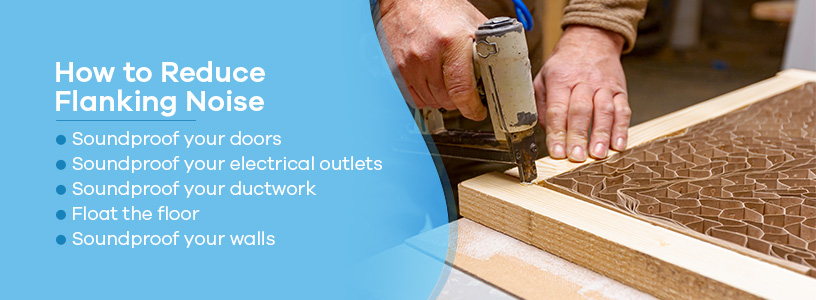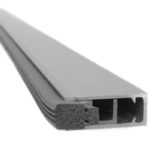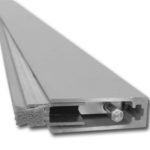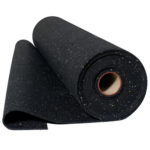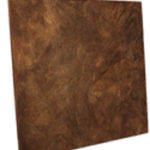
Table of Contents:
What Is Flanking Noise
Flanking Noise Paths
Reduce Flanking Noise
So you’ve soundproofed the wall leading from your apartment to the apartment next door, but somehow there’s still noise coming from that direction, although you can’t pinpoint exactly where it’s coming from. If this describes your situation, you may be the victim of flanking noise. But what is flanking noise, and what can you do about it?
What Is Flanking Noise?
Flanking noise, also called “flanking transmission,” refers to noise entering an area from an indirect method. Even if you are blocking noise coming directly through to your unit through a wall or the floor, there may be noises bouncing off other surfaces and indirectly entering your area, bypassing any obstacles you put in place to block it.
Flanking can occur through numerous scenarios. Sound may travel through floor systems and bypass the wall that separates the rooms. Flanking noise can occur through ceilings, especially if there’s an attic above the rooms. Additionally, air ducts are a common culprit for transmitting sounds between rooms and floors.
This unwanted noise can be frustrating, especially when you make constant efforts to reduce the disturbing sounds. Even after implementing various soundproofing methods, you could find yourself wondering how the sound from a nearby apartment or an attached home could make its way into your living space.
Potential Flanking Noise Path Sources
To deal with flanking noise, you first have to identify the source. This can be difficult since the noise is reaching you indirectly. Where could your flanking noise be coming from?
If you’ve only soundproofed your walls, then floors and ceilings are one likely source of flanking noise. The sounds your neighbors create may not be able to pass through the wall, but some of them are probably passing through their ceilings and may find their way into your home.
This isn’t the only possible culprit, however. Poorly soundproofed ductwork is another common source of unwanted flanking noise. Ductwork has lots of open space for sound waves to bounce off and travel through to get into your apartment.
Believe it or not, your electrical outlets are another possibility. If your outlets aren’t secured properly, the open spaces around them can provide a port of entry for sound waves to slip through.
Then there are your doors and windows. A well-soundproofed wall is worthless if it has a poorly soundproofed door or window in it. In fact, if your door is not properly treated for sound control, the unwanted sound could even travel down the hall from a neighbor’s apartment and into your home through that door.
How to Reduce Flanking Noise
There are many ways you can reduce flanking noise in your house or apartment. Think of this unwanted sound like an opposing army surrounding yours. You’ll need to strategically block the opposing force’s entry to keep your army safe. It’s the same idea with flanking noise. Here are the ways you can defend your home from flanking noise:
- Soundproof your doors: Flanking noise is bound to find its way through your door, especially if it is flimsy or has a gap between its bottom and the floor. One possible solution is to invest in a solid, heavy door instead of a flimsy, hollow one. Even hollow doors with insulation inside can be great for your energy bill but poor for reducing flanking noise. Another option is to install door seals and sweeps to close the opening below your door to keep unwanted sounds from entering your rooms.
- Soundproof your electrical outlets: Electrical outlets are a common location for letting flanking noise into your living space, especially if the apartment next door’s electrical outlet is in the same spot on the other side of the wall. Try filling any cracks around your outlet with expandable foam products. You can also try stuffing the open space behind your electrical outlet with pieces of acoustic fiberglass to reduce flanking noise.
- Soundproof your ductwork: If your apartment shares the same ductwork as the other apartments nearby, you basically have sound tunnels connecting yourself to the other tenants. If you can take soundproofing the ductwork into your own hands, then you should consider wrapping the ducts with HVAC-rated acoustic pipe wrapping. Also make sure to fill up as much empty space around the pipes as possible with acoustic fiberglass.
- Float the floor: When flanking noise is disturbing you from below, you may need to float your floors with soundproofing flooring underlayments. These will boost the sound-absorbing quality of your floors to keep sounds coming from below from entering your living space. If you have access to the rooms above your apartment, you can even float those floors to reduce the amount of sound coming from above.
- Soundproof your walls: If you’re hearing noise from the neighbors next door, above, or below, you’ll want to soundproof your walls. A great way to help reduce sound coming through your walls is to buy art acoustic panels. You can add style to your room through a custom art piece and soundproof your walls at the same time!
Soundproof Cow Can Help Reduce Flanking Noise in Your Home
The best way to reduce flanking noise is to block any holes, cracks or other openings where sound may be getting through with soundproof material. Of course, the first step is to locate those openings. This can seem like a challenging task. Fortunately, Soundproof Cow is on your side. We offer a free acoustic analysis for individuals looking to control the sound in their homes. We can let you know where the most unwanted sound is likely to be coming in and which products are best suited to solving the problem.
If unwanted sounds have been driving you crazy, and you can’t figure out why, take heart! Contact Soundproof Cow and let us root out and reduce your flanking noise right away!



